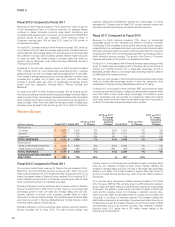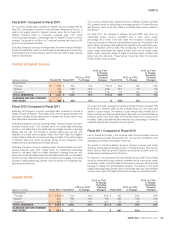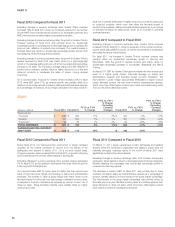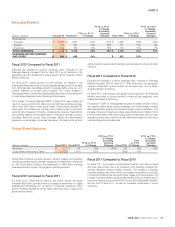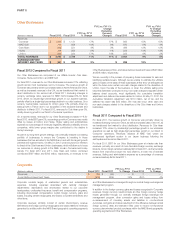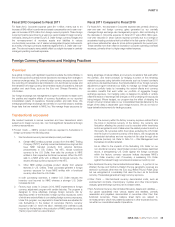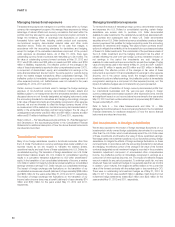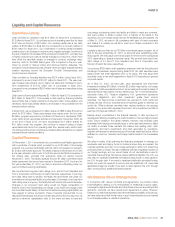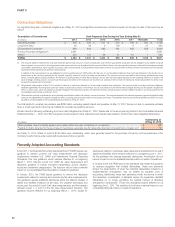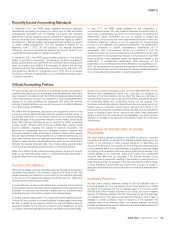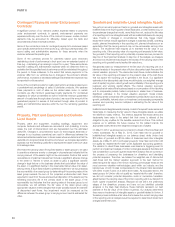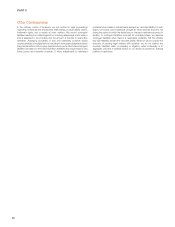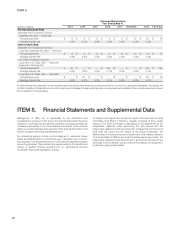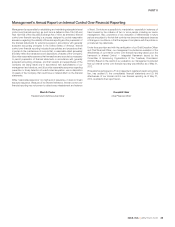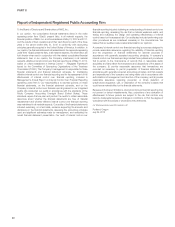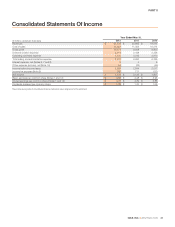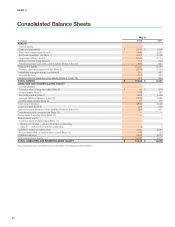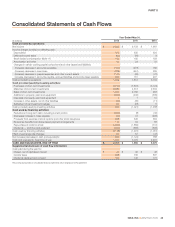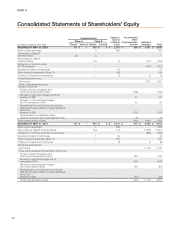Nike 2012 Annual Report Download - page 34
Download and view the complete annual report
Please find page 34 of the 2012 Nike annual report below. You can navigate through the pages in the report by either clicking on the pages listed below, or by using the keyword search tool below to find specific information within the annual report.PART II
Contingent Payments under Endorsement
Contracts
A significant portion of our demand creation expense relates to payments
under endorsement contracts. In general, endorsement payments are
expensed uniformly over the term of the contract. However, certain contract
elements may be accounted for differently, based upon the facts and
circumstances of each individual contract.
Some of the contracts provide for contingent payments to endorsers based
upon specific achievements in their sports (e.g., winning a championship). We
record selling and administrative expense for these amounts when the
endorser achieves the specific goal.
Some of the contracts provide for payments based upon endorsers
maintaining a level of performance in their sport over an extended period of
time (e.g., maintaining a top ranking in a sport for a year). These amounts are
reported in selling and administrative expense when we determine that it is
probable that the specified level of performance will be maintained throughout
the period. In these instances, to the extent that actual payments to the
endorser differ from our estimate due to changes in the endorser’s athletic
performance, increased or decreased selling and administrative expense may
be reported in a future period.
Some of the contracts provide for royalty payments to endorsers based upon
a predetermined percentage of sales of particular products. We expense
these payments in cost of sales as the related sales occur. In certain
contracts, we offer minimum guaranteed royalty payments. For contractual
obligations for which we estimate we will not meet the minimum guaranteed
amount of royalty fees through sales of product, we record the amount of the
guaranteed payment in excess of that earned through sales of product in
selling and administrative expense uniformly over the remaining guarantee
period.
Property, Plant and Equipment and Definite-
Lived Assets
Property, plant and equipment, including buildings, equipment, and
computer hardware and software are recorded at cost (including, in some
cases, the cost of internal labor) and are depreciated over the estimated
useful life. Changes in circumstances (such as technological advances or
changes to our business operations) can result in differences between the
actual and estimated useful lives. In those cases where we determine that the
useful life of a long-lived asset should be shortened, we increase depreciation
expense over the remaining useful life to depreciate the asset’s net book value
to its salvage value.
We review the carrying value of long-lived assets or asset groups to be used
in operations whenever events or changes in circumstances indicate that the
carrying amount of the assets might not be recoverable. Factors that would
necessitate an impairment assessment include a significant adverse change
in the extent or manner in which an asset is used, a significant adverse
change in legal factors or the business climate that could affect the value of
the asset, or a significant decline in the observable market value of an asset,
among others. If such facts indicate a potential impairment, we would assess
the recoverability of an asset group by determining if the carrying value of the
asset group exceeds the sum of the projected undiscounted cash flows
expected to result from the use and eventual disposition of the assets over the
remaining economic life of the primary asset in the asset group. If the
recoverability test indicates that the carrying value of the asset group is not
recoverable, we will estimate the fair value of the asset group using
appropriate valuation methodologies that would typically include an estimate
of discounted cash flows. Any impairment would be measured as the
difference between the asset group’s carrying amount and its estimated fair
value.
Goodwill and Indefinite-Lived Intangible Assets
We perform annual impairment tests on goodwill and intangible assets with
indefinite lives in the fourth quarter of each fiscal year, or when events occur or
circumstances change that would, more likely than not, reduce the fair value
of a reporting unit or an intangible asset with an indefinite life below its carrying
value. Events or changes in circumstances that may trigger interim
impairment reviews include significant changes in business climate, operating
results, planned investments in the reporting unit, planned divestitures or an
expectation that the carrying amount may not be recoverable, among other
factors. The impairment test requires us to estimate the fair value of our
reporting units. If the carrying value of a reporting unit exceeds its fair value,
the goodwill of that reporting unit is potentially impaired and we proceed to
step two of the impairment analysis. In step two of the analysis, we measure
and record an impairment loss equal to the excess of the carrying value of the
reporting unit’s goodwill over its implied fair value if any.
We generally base our measurement of the fair value of a reporting unit on a
blended analysis of the present value of future discounted cash flows and the
market valuation approach. The discounted cash flows model indicates the
fair value of the reporting unit based on the present value of the cash flows
that we expect the reporting unit to generate in the future. Our significant
estimates in the discounted cash flows model include: our weighted average
cost of capital; long-term rate of growth and profitability of the reporting unit’s
business; and working capital effects. The market valuation approach
indicates the fair value of the business based on a comparison of the reporting
unit to comparable publicly traded companies in similar lines of business.
Significant estimates in the market valuation approach model include
identifying similar companies with comparable business factors such as size,
growth, profitability, risk and return on investment, and assessing comparable
revenue and operating income multiples in estimating the fair value of the
reporting unit.
Indefinite-lived intangible assets primarily consist of acquired trade names and
trademarks. In measuring the fair value for these intangible assets, we utilize
the relief-from-royalty method. This method assumes that trade names and
trademarks have value to the extent that their owner is relieved of the
obligation to pay royalties for the benefits received from them. This method
requires us to estimate the future revenue for the related brands, the
appropriate royalty rate and the weighted average cost of capital.
On May 31, 2012, we announced our intention to divest of the Cole Haan and
Umbro businesses. As of May 31, 2012, Cole Haan had no goodwill or
indefinite-lived intangible assets on our balance sheet, while Umbro had
$70 million of goodwill and $164 million of trademark and other intangible
assets. As of May 31, 2012, both asset groups for Cole Haan and Umbro did
not quality as “assets-held-for-sale” under applicable accounting guidance.
The decision to divest these businesses was deemed a triggering event to
perform an impairment analysis of Umbro’s intangible assets at that date and
was considered in our fourth quarter impairment analysis. We are currently in
the process of preparing the businesses for divestiture and identifying
potential acquirers. Therefore, we believe the weighted use of discounted
cash flows and the market valuation approach is the best method for
determining the fair value of the Umbro reporting unit because these are the
most common valuation methodologies used within our industry; and the
blended use of both models compensates for the inherent risks associated
with either model if used on a stand-alone basis. As discussed above, the
asset groups for Umbro did not qualify as “assets-held-for-sale”; therefore,
we did not consider potential disposition costs or cumulative translation
adjustments in the carrying value of the Umbro reporting unit in our fiscal 2012
fourth quarter impairment analysis. Because we are still in the preliminary
stages of the divestiture process and have not yet identified potential
acquirers or the likely deal structure, these methods represent our best
estimate of the fair value of the Umbro business. Our analysis determined
there was no impairment of intangible assets or goodwill related to Umbro. If
the sales process indicates a fair value that is below the current carrying value
of the reporting unit, an analysis would be required to determine if impairment
charges exist at that point.
34


